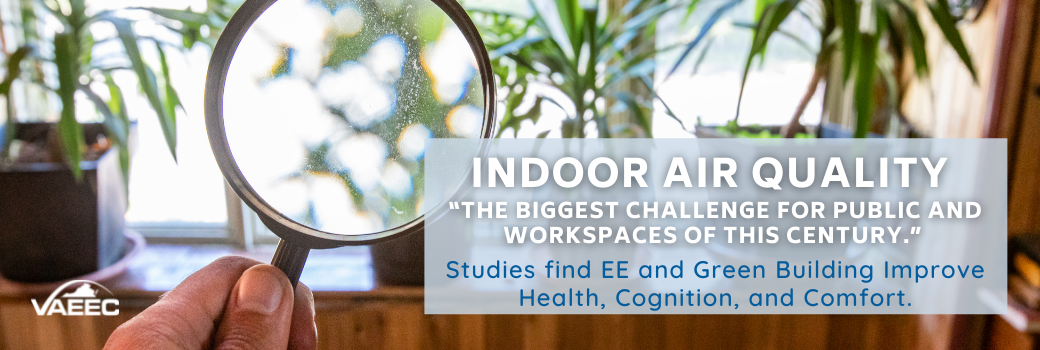Virginia’s energy efficiency industry gathered together to learn and connect at the VAEEC’s annual Spring Forum on May 23rd. Nearly 100 energy efficiency professionals participated in the event, which included a keynote address, business meeting with Board of Directors elections, membership spotlight, plenary session, and networking time. Thank you to our sponsors, speakers, and attendees for making this event a great success!
Prior to the start of the event, around 20 attendees came together to tour the award-winning, LEED Gold-certified Fairfield Area Library. Opened in late 2019, the library is Henrico County’s 18th government or school building to earn LEED certification for sustainable design and construction and reduced environmental impact. Encompassing 45,000 SF, it features LED interior and exterior lighting, third-party verification of its mechanical and electrical systems, and long-term energy performance verification. Building materials include sustainably harvested wood, rapidly renewable cork, and low-emitting materials. The tour was led by Andrea Quilici and Chuck Wray from the project’s architect firm, Quinn Evans, and Carrie Webster, Henrico County‘s Energy Manager.
The Spring Forum then kicked off with an opening presentation from Executive Director, Chelsea Harnish, who provided an update about Virginia’s energy efficiency industry and the organization’s accomplishments from 2022 to today. This included the VAEEC’s 2023-2025 Strategic Plan objectives and our new Energizing Efficiency Campaign.
Next was a keynote address from Theresa Backhus, Director of the Building Innovation Hub (HUB) with the Institute for Market Transformation (IMT). The HUB supports high-performing buildings across D.C., Maryland, and Virginia by connecting decision-makers, localities, contractors, building owners, and others to resources that make buildings energy-efficient and resilient. Theresa shared an overview of the resources the HUB provides, as well as the building decarbonization opportunities available through federal funding. She also gave an overview of the DMV’s building code updates and building energy performance standards with an emphasis on what Virginia localities can do to address energy efficiency in a Dillion Rule state.
“It’s important not to forget that at the end of the day, buildings are for people; they must support the community they surround.” – Theresa Backhus, Building Innovation Hub (IMT)
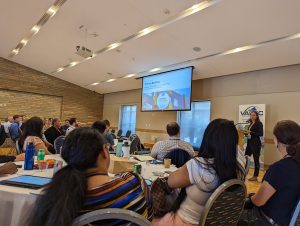 Approximately 1/3 of our greenhouse gas emissions are from the new and existing building stock. The HUB emphasizes the importance of transitioning from looking at buildings as the problem to looking at them as the opportunity. And above all, we cannot forget that buildings are for people, which is especially true when you consider that we spend roughly 90% of our lives in buildings. Therefore, they must support the community around them by focusing on energy efficiency, resiliency, and health and safety.
Approximately 1/3 of our greenhouse gas emissions are from the new and existing building stock. The HUB emphasizes the importance of transitioning from looking at buildings as the problem to looking at them as the opportunity. And above all, we cannot forget that buildings are for people, which is especially true when you consider that we spend roughly 90% of our lives in buildings. Therefore, they must support the community around them by focusing on energy efficiency, resiliency, and health and safety.
Next, John Morrill, led the business portion of the event, which started off with our 2023 Board of Directors election. VAEEC members re-elected two board members:
- Bryna Dunn, Moseley Architects (1st full term)
- Leigh Anne Ratliff, Trane Technologies (2nd term)
Members then voted to elect two new directors to the Board:
- McKenna Dunbar, Sierra Club Virginia Chapter
- Lesley Fore, Alliance to Save Energy
We are thrilled to add new voices to our leadership and to continue working with our two re-elected members. We would also like to recognize our outgoing Board members, Maggie Kelley Riggins, with the Southeast Energy Efficiency Alliance, and Joyce Bodoh, with Rappahannock Electric Cooperative, for their outstanding leadership to the organization.
 Attendees were next treated to a round robin of updates and successes from our members before moving into a networking break. After reconvening, the plenary session began. Meeting the Moment for Building Demand touched on the how the federal climate initiatives passed by the Biden administration will change the energy landscape for decades to come, before moving into how experts from across the field are planning to implement successful programs and projects using the funds. The discussion also included how we can make this round of funding more “durable” than that of the American Recovery & Reinvestment Act (ARRA) era to create systemic change and avoid the “one and done” projects.
Attendees were next treated to a round robin of updates and successes from our members before moving into a networking break. After reconvening, the plenary session began. Meeting the Moment for Building Demand touched on the how the federal climate initiatives passed by the Biden administration will change the energy landscape for decades to come, before moving into how experts from across the field are planning to implement successful programs and projects using the funds. The discussion also included how we can make this round of funding more “durable” than that of the American Recovery & Reinvestment Act (ARRA) era to create systemic change and avoid the “one and done” projects.
“We don’t have a shortage of money, but we need an easy button now to effectively deploy it. The Inflation Reduction Act is our window of opportunity to create a unified customer experience.” – Andrew Grigsby, Viridiant
Speakers included:
- Bettina Bergoo, Virginia Energy: Along with moderating the session, Bettina also spoke on Virginia Energy’s role and plans with the federal funding and the guidance currently available for HOMES/HEERHA.
- Andrew Grigsby, Viridiant: Andrew spoke on Viridiant’s success with the BENEFIT grant and how that can serve as a model for future programs. He also went into detail about the need for a unified customer experience that includes financing options available.
- Marco Rubin, Virginia Innovation Partnership Corporation: Marco discussed the startup environment since the passage of the inflation Reduction Act and Bipartisan Infrastructure Law, including looking the economic conditions at the micro-, macro-, and Marco-levels.
- Joyce Bodoh, Rappahannock Electric Cooperative: Given her role as the Director of Energy Solutions and Clean Energy at one of Virginia’s electric cooperatives, Joyce focused on how federal funding can be braided with the federal funding. She also spoke to the importance of customer data access and shared how REC’s summer savings pilot program provided $12k in bill credits to customers and saved REC $70K in wholesale power.
- Kim Strahm, Community Housing Partners: After having developed a successful workforce development program using funds from the 2009 ARRA, Kim shared best practices and lessons learned for developing and implementing programs using federal funding. Through CHP’s position on both the demand- and supply-side of high-performance buildings, Kim kept coming back to the need for a trained workforce.
As always, this event would not have been possible without our sponsors, speakers, and attendees. We would also like to thank the VAEEC Education & Events Committee for helping staff plan such a successful event.
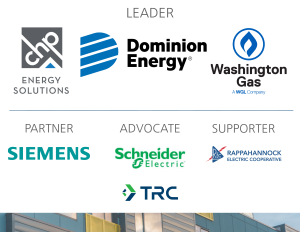 Be sure to save the date for our fall Energy Efficiency Forum– October 4th (virtual), October 5th (in-person, University of Richmond). We hope to see you there.
Be sure to save the date for our fall Energy Efficiency Forum– October 4th (virtual), October 5th (in-person, University of Richmond). We hope to see you there.
Additional event information, including speaker biographies and sponsor features, can be found in the event program. Event attendees received a PDF of the event’s presentation in the post-event email. Contact info@vaeec.org if you did not receive it. Events photos can be viewed in the photo gallery below.
The passage of the Virginia Clean Economy Act set lofty energy savings goals for the investor-owned utilities, in order to meet their greenhouse gas reduction targets by 2045. While there are multiple paths to achieving these goals, a recent report from ACEEE suggests that one key to success could be stronger building codes.
Over the next five years, the Bipartisan Infrastructure Law (BIL) and the Inflation Reduction Act (IRA) will allocate $1.2M towards code training and enforcement. In the ACEEE report, Virginia ranked sixth as one of the best positioned states to take advantage of this new funding to improve its energy codes across the residential, commercial, and industrial sectors.
According to ACEEE, Virginia needs to see the most emissions reduction by 2030 to meet its policy targets. While the VCEA savings targets are focused on cleaning up the grid, building codes can address both new construction and the existing building stock, which accounts for 40% of energy consumption nationwide. Based on their analysis, ACEEE found that Virginia needs to reduce emissions by more than 50% to meet the VCEA goals.
In Virginia, the commercial building code aligns with the IECC model code, but gaps in enforcement and code official training mean the state could save an additional 5-10% on energy costs by utilizing federal funds.
On the residential side, our current code is missing two critical provisions that would align with the 2021 IECC model code – improved R-value for wall insulation, and enhanced building tightness to reduce the number of air changes per hour. By adopting these amendments, ACEEE found that there could be a 17.8% reduction in energy costs. (Learn about the the Virginia building code update process on our website.)
The report also found that Virginia ranked in the median for homes built nationwide. Meaning, approximately 1700 new homes were built across the state in 2019, with the data projecting similar growth moving forward. New home construction is a great opportunity for increased energy efficiency.
Bringing the Uniform Statewide Building Code up to IECC standards and improving code enforcement, can help the state achieve up to 20% in residential energy cost-savings.
While the building code applies more directly to new construction, retrofits are a pathway to reducing emissions and costs in existing buildings as well. ACEEE also looked at carbon emissions from existing buildings and found that, in 2019, over 5 tons of CO2 per capita – equivalent to driving 12,000 miles in a standard gas SUV – were released from Virginia’s existing building stock. By 2050, as much as two-thirds of existing buildings statewide will have been constructed prior to 2020, therefore it is increasingly critical to address existing buildings, in addition to new construction. Utility residential energy efficiency programs will play a major role in reducing emissions from existing housing, thereby highlighting the need for a holistic approach to reducing carbon emissions from Virginia’s built environment.
The timing on the implementation of these federal dollars couldn’t be better. However, deployment of these funds must be part of a comprehensive strategy that takes into account Virginia policy. Facilitating these types of conversations with decision-makers is a role that the Virginia Energy Efficiency Council, and our members, can play. We look forward to that opportunity. Check our new federal funding page and our monthly e-newsletters for continued updates on this important work.
The VAEEC’s 2022 Energy Efficiency Forum brought together the Commonwealth’s energy efficiency community on October 31st and November 1st. A huge thank you to our sponsors, speakers, award winners, and attendees for making this event a great success!
In order to make the event more accessible to those near and far and to provide a diverse array of speakers from across the country, day one was fully virtual. It consisted of four breakout sessions and a networking session.
A Tale of Two Heat Pumps: Heat pump adoption is a priority for the Biden administration, and the technology has long been proven to be safer and more efficient than traditional boilers. However, barriers exist to widespread use. This session discussed the barriers and opportunities with experts from the NE and SE to address these regions’ needs and perspectives. Speakers included Maggie Kelley Riggins (Southeast Energy Efficiency Alliance), Dan Lis (Northeast Energy Efficiency Partnerships), Louis O’Berry (Rappahannock Electric Cooperative), and Dan York (American Council for an Energy-Efficient Economy, moderator).
Using Less to Get More: The Role of Energy Efficiency in Decarbonization: Decarbonization has become a buzzword lately with the passage of historic federal laws. During this panel, attendees learned from those implementing successful decarbonization programs with an eye on energy efficiency. Examples included both state- and utility-run programs, including what one of the Commonwealth’s gas utilities has in the works. Erich Evans (Columbia Gas), Caterina “Katy” Hatcher (U.S. Environmental Protection Agency), Shaun Hoyte (Con Edison), and Edward Yim (ACEEE) were the speakers, while Solome Girma (D.C. Sustainable Energy Utility) moderated.
Proof of Concept: Approaches to Energy Efficiency: This case study session was designed to provide the value of shared experience and knowledge from those who have successfully navigated new technologies and programs. Robert Hart (Lawrence Berkeley National Lab) covered the advancements in window construction. Betsy Farrell Garcia and Mackenzie Stagg (Front Porch Initiative) gave an overview of rural, low-income housing programs from experts in the field. Joyce Bodoh (Rappahannock Electric Cooperative) and Brett Hood (Community Housing Partners) moderated.
Efficiency First: Strategies to Improve Municipal Buildings: Local governments and public school systems often face a unique set of challenges when it comes to the comfort, cost, and health of their buildings. This session focused on inventive ways this sector is improving its buildings through efficient and equitable programs. Speakers included Joanne Bissetta (Massachusetts Department of Energy Resources), Ann Livingston (Southeast Sustainability Directors Network), Christopher Russell (Maryland Energy Administration), and Kristel Riddervold (City of Charlottesville, VA, moderator).
Attendees gathered in person for day two at the University of Richmond Jepson Alumni Center in Richmond. The day began with an opening presentation from Executive Director, Chelsea Harnish. Attendees were updated on the organization’s 2022 accomplishments and our 2023 priorities, as well as an overview of the Commonwealth’s energy efficiency industry.
Everyone was then treated to a keynote address from Jennifer Bumgarner, the Principal Deputy Assistant Secretary, Office of Congressional and Intergovernmental Affairs at the U.S. Department of Energy (DOE). Ms. Bumgarner provided a breakdown of the Bipartisan Infrastructure Law (BIL) and Inflation Reduction Act (IRA) funding, as well as how the DOE is preparing to use this funding for the expansion of programs for state and local benefits and workforce development. Highlights of the address included approximations of when applications for the different buckets of funding will open, tips on what to include in your proposals, and DOE resources to help you navigate all of the options.
After a break of networking and snacks, attendees came back together for the plenary session, Preparing for Impact: New Funding Opportunities to Accelerate Energy Efficiency. Between the Bipartisan Infrastructure Law and the Inflation Reduction Act, states and localities are receiving a historic investment in clean energy. But what does that mean for Virginia? Experts in state and local governments, industry, and policy provided a breakdown and predictions for what’s next for energy efficiency in the Commonwealth. Speakers included Sabine Rogers (AnnDyl Policy Group), Bettina Bergoo (Virginia Energy), Abby Campbell Singer (Siemens USA), John Morrill (Fairfax County Government), and Rebecca Hui (Virginia Energy Efficiency Council, moderator).
Next, we had the privilege of hosting our seventh annual Virginia Energy Efficiency Leadership Awards ceremony. One project and two programs were recognized for their incredible energy efficiency contributions to the Commonwealth. For information on each winning project, visit our 2022 Awards page.
Finally, the event concluded with an on-site networking reception. It is always a pleasure to connect with many of our members and others in the industry face-to-face, and this was no exception.
Thank you to our sponsors, speakers, award winners, and event attendees for making this one of our best events to date. Click here to view photos of the event. Additional event information, including speaker biographies and sponsor features, can be found in the event program.
Event attendees received recordings for each of the four breakout sessions in the post-event email. Presentation PDFs can be viewed at the links above.
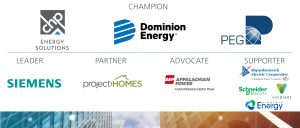
 Virginia’s High-Performance Buildings Act (HB2001) was signed into law in 2021, with the goal to drive more efficient, resilient, and future-proof buildings. The law updated the building performance standards for state/public buildings by adding electric vehicle charging and infrastructure and utility metering requirements. It also created new building performance standards for local governments.
Virginia’s High-Performance Buildings Act (HB2001) was signed into law in 2021, with the goal to drive more efficient, resilient, and future-proof buildings. The law updated the building performance standards for state/public buildings by adding electric vehicle charging and infrastructure and utility metering requirements. It also created new building performance standards for local governments.
Since the act was introduced in the General Assembly, the VAEEC and key partners have been working with the bill patron and others to clarify the requirements and identify potential updates to the existing law. This included working with the Department of General Services (DGS) to update the Virginia Energy Conservation and Environmental Standards (VEES) for the first time since 2012.
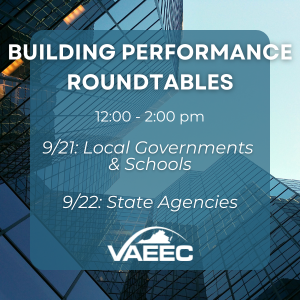 In September of this year, we held two building performance roundtable discussions with localities, state agencies, schools, architecture and design firms, engineering firms, and energy service companies. The goals were to educate stakeholders about the requirements and identify ways to update the law so that it better suits the needs of the intended audience.
In September of this year, we held two building performance roundtable discussions with localities, state agencies, schools, architecture and design firms, engineering firms, and energy service companies. The goals were to educate stakeholders about the requirements and identify ways to update the law so that it better suits the needs of the intended audience.
VAEEC Board members Elizabeth Beardsley (U.S. Green Building Council) and Bryna Dunn (Moseley Architects) started off the roundtables with an overview of the law and the pathways to compliance.
By July 1, 2021, state agency buildings were mandated to:
- Be designed, constructed, verified, and operated to comply with a high-performance building certification program,
- Comply with VEES,
- Have sufficient zero-emission vehicle infrastructure, and
- Include features that measure energy consumption and associated carbon emissions.
In the law, there is an option to exceed the above design and construction standards with prior written approval from the Director of DGS. The Director of DGS can also grant exemptions for specific projects if it is impractical to build or renovate to the standards. HB2001 also added a new reporting requirement for state agencies: an annual report is due to the Governor by January 1st detailing the energy efficiency and associated carbon emissions metrics for each applicable building built or renovated during the prior fiscal year.
Beginning July 1, 2021, buildings for localities with populations of 100,000 or more must:
- Be designed, constructed, verified, and operated to comply with one of three high-performance building certification programs (LEED certification, Green Globes Certification, or VEES verification),
- Have sufficient zero-emission vehicle charging and fueling infrastructure,
- Include features that measure the energy consumption and associated carbon emissions, and
- Incorporate appropriate resilience and distributed energy features.
Remaining localities will need to abide by these requirements beginning July 1, 2023.
Localities can seek an exemption if it is impractical to build or renovate to the standards. Local governments also have the option to adopt their own green design and construction program with standards that are more stringent than those required by law.
The above mandates apply to new buildings over 5,000 square feet and renovations where the cost of the renovation exceeds 50% of the value of the building. Smaller projects (those that are less than 20,000 gross square feet in size) have the option to achieve an ENERGY STAR certification with the implementation of mechanical, electrical, plumbing, and envelope commissioning instead.
The three compliance pathways are LEED certification, Green Globes Certification, or VEES verification. LEED v4 is the newest version of the LEED green building certification. A building must comply with a set of prerequisites, but then you can select a minimum number of criteria depending on what makes the most sense for your building. Similarly, Green Globes provides the option to pick and choose a minimum number of criteria, but this certification program does not have prerequisites. VEES follows the International Green Construction Code, so a building must comply with all of the stated requirements.
Guidance, resources, and support exist to help state agencies and local governments navigate and meet the law’s requirements. Starting October 1st, the Southeast Energy Efficiency Alliance (SEEA) will be providing technical assistance with policy creation and stakeholder engagement. They will also be providing technical assistance and training on the Building Energy Analysis Manager (BEAM) tool, which helps states and communities achieve building energy policy goals.
Additionally, Moseley Architects created a Requirements Summary for HB2001, which includes an option comparison. The U.S. Green Building Council (USGBC) curated two resources specific to green building in Virginia, Getting Started with High Performance Green Building: A Guide for Virginia Localities and VA HB2001: Summary & FAQ for Local Governments. USGBC also created Inflation Reduction Act: Buildings Provisions, which state agencies and localities will find helpful as they navigate the opportunities in the Inflation Reduction Act. These resources can be viewed at the respective links above, as well as in the VAEEC government clearinghouse. The clearinghouse also includes additional green building resources for our local government, academic, and state agency members.
Facilitated discussions took up the remainder of the event. Attendees were encouraged to ask questions and provide feedback, including:
- What part(s) of the legislation is consistent with objectives already set by your locality/agency?
- What part(s) of the legislation is helping move forward objectives that your locality/agency supports but doesn’t already have policies around?
- What clarifications or additions would you offer to update the current language?
- How can VAEEC and our partners support you in meeting your sustainability goals and the requirements of this legislation?
The presentation PDFs are available to download (local governments and schools, state agencies), and recordings of both roundtables can be viewed on the VAEEC YouTube channel. To learn more about building performance, register to attend our Energy Efficiency Forum on October 31st (virtual) and November 1st (in-person, Richmond). Additional questions can be addressed to Jessica Greene (jessica@vaeec.org).
A new program launched by Dominion Energy provides a kit of smart home technology with an instant rebate to eligible customers in Virginia.
New Smart Home technology helps customers save energy and be more aware of the electric use in their home. To help customers adopt this new technology, Dominion Energy is offering eligible customers in Virginia as well as North Carolina rebates on smart home products.
The Smart Home program gives customers the opportunity to purchase a smart home kit on the program website, smarthome.domsavings.com, with an instant $25 rebate. The base kit includes a Kasa Smart Plug with Energy Monitoring, two Kasa Smart Wi-Fi Plug Minis, the Philips Hue Smart White Ambiance LED Starter Kit and a Philips Hue Motion Sensor.
Customers can enhance their smart home setup by adding an ecobee Smart Thermostat ($50 rebate) or Sense Home Energy Monitor ($70 rebate) to their kit purchase, and each is available with an additional instant rebate. The Sense Energy Monitor must be installed in your electric panel by a licensed electrician.
 As such, electricians as well as solar installers with on-staff licensed electricians can become participating contractors with Dominion’s Smart Home Program. Participating contractors benefit from the program in many ways including getting listed on Dominion’s website and access to free training. To learn more about becoming a participating contractor including the eligibility requirements, visit www.dom-vendor.com.
As such, electricians as well as solar installers with on-staff licensed electricians can become participating contractors with Dominion’s Smart Home Program. Participating contractors benefit from the program in many ways including getting listed on Dominion’s website and access to free training. To learn more about becoming a participating contractor including the eligibility requirements, visit www.dom-vendor.com.
With integration between smart home devices and a smartphone and / or voice assistant, customers will have increased control over their home’s energy use, even remotely. Customers will have the ability to put your devices on a schedule, allow devices to perform energy-efficient actions on their own, and connect to other smart technologies.
Learn more about how the program helps customers leverage integrated energy-efficient smart home products to reduce and manage a home’s energy consumption. Visit smarthome.domsavings.com for more information. Terms and Conditions and eligibility requirements apply. Subject to change at any time.
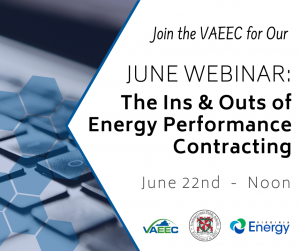 The Virginia Energy Efficiency Council (VAEEC) recently hosted a webinar, The Ins and Outs of Energy Performance Contracting, featuring Virginia Energy and Loudoun County Public Schools. The webinar provided an overview of how Energy Performance Contracting (EPC) works and the recent improvements to Virginia’s program. Loudoun County Public Schools recounted their experiences using EPC to enhance their buildings and meet their capital improvement and sustainability goals. Speakers included Nam Nguyen (Virginia Energy), Nick Polier (Virginia Energy), Michael Barancewicz (Loudoun County Public Schools), and Susan Gerson (Loudoun County Public Schools).
The Virginia Energy Efficiency Council (VAEEC) recently hosted a webinar, The Ins and Outs of Energy Performance Contracting, featuring Virginia Energy and Loudoun County Public Schools. The webinar provided an overview of how Energy Performance Contracting (EPC) works and the recent improvements to Virginia’s program. Loudoun County Public Schools recounted their experiences using EPC to enhance their buildings and meet their capital improvement and sustainability goals. Speakers included Nam Nguyen (Virginia Energy), Nick Polier (Virginia Energy), Michael Barancewicz (Loudoun County Public Schools), and Susan Gerson (Loudoun County Public Schools).
Energy Performance Contracting (EPC) is a budget-neutral option for state agencies, localities, public schools, and other public bodies to finance building upgrades while reducing energy use. Through EPC, public entities are able to improve their building performance, address maintenance needs, and reduce their energy consumption – all while achieving a guaranteed level of energy savings. Virginia’s program was established in 2002. To date, there have been more than 280 projects and over $1B in project investment.
EPC projects and customers include public K-12 schools and universities, localities, state agencies, regional jails, and correctional facilities. Virginia Energy provides support throughout the entire EPC process – from the design phase all the way through measurement and verification. This support comes at no cost to the customer and includes all necessary documents and templates to reduce time requirements. Customers are able to select an energy service company (ESCO) to perform the work from a prequalified vendor pool, which expedites the procurement process. The avoided costs from building upgrades pay for the cost of the project and there is a guaranteed energy saving.
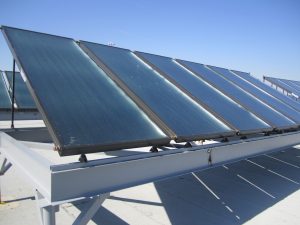 During this year’s General Assembly Session, the VAEEC worked with Virginia Energy and our ESCO members to update the Commonwealth’s existing EPC legislation. Once these laws take effect, EPC will be able to finance all roof repairs and full replacements, allowing public buildings to use EPC to become solar-ready. This will provide public bodies with the opportunity to fully finance solar under an EPC (see our fact sheet for more information).
During this year’s General Assembly Session, the VAEEC worked with Virginia Energy and our ESCO members to update the Commonwealth’s existing EPC legislation. Once these laws take effect, EPC will be able to finance all roof repairs and full replacements, allowing public buildings to use EPC to become solar-ready. This will provide public bodies with the opportunity to fully finance solar under an EPC (see our fact sheet for more information).
EPC has been particularly beneficial to some localities, such as Loudoun County, which is the fastest-growing county in Virginia with the third-largest school division. With sustainability in mind and the challenge of aging infrastructure, Loudoun County Public Schools reached a point where they could no longer reduce their energy usage without making significant investments. This led them to partner with Virginia Energy to pursue EPC. Through this first pilot project, LCPS saw a 75% kWh reduction, which was even better than the guaranteed level of energy savings. This positive experience led LCPS to continue to use EPC to not only address deferred maintenance and equipment upgrades, but to meet their capital improvement and sustainability goals.
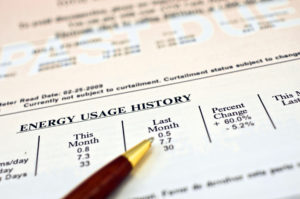 EPC provides the school system with the fiscal advantage of financing energy efficiency retrofits from realized future energy savings. Additional benefits include expertise in design, planning, implementation, and communication; resources that guarantee long-term success; the inclusion of non-energy conservation measures projects (such as security systems); and a trusted partnership between LCPS and their selected ESCO, CMTA. Not only did CMTA understand the nuances of working in an educational environment, but they offered staff training for LCPS employees and have participated in educational opportunities for students.
EPC provides the school system with the fiscal advantage of financing energy efficiency retrofits from realized future energy savings. Additional benefits include expertise in design, planning, implementation, and communication; resources that guarantee long-term success; the inclusion of non-energy conservation measures projects (such as security systems); and a trusted partnership between LCPS and their selected ESCO, CMTA. Not only did CMTA understand the nuances of working in an educational environment, but they offered staff training for LCPS employees and have participated in educational opportunities for students.
If you are interested in learning more about energy performance contracting, check out the resources below.
VAEEC EPC fact sheet (6/2022)
VAEEC EPC webpage
Virginia Energy EPC webpage
Webinar Presentation PDF (6/2022)
Webinar Recording link (6/2022)
The Virginia Energy Efficiency Council was excited to gather in person with Virginia’s energy efficiency industry leaders for our annual Spring Forum on May 5th. Thank you to our sponsors, speakers, and attendees for making this event a great success!
Our biannual forums are known for their ability to bring together Virginia’s energy efficiency leaders to make valuable connections, and this event did not disappoint. Energy efficiency professionals convened in person at the Dorey Recreation Center in Henrico County for ample networking time, a keynote address from a prominent energy-efficiency champion, educational presentations, a membership spotlight, and the organization’s annual business meeting with Board elections.
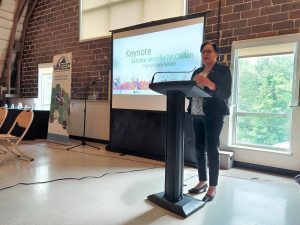
Senator Jennifer McClellan
The event kicked off with a brief opening presentation from Executive Director, Chelsea Harnish, who provided an update on the organization’s 2022 accomplishments thus far. Attendees were then treated to a keynote address from Virginia State Senator Jennifer McClellan, a long-time advocate for clean energy in the Commonwealth. Senator McClellan began by stating the importance of clean energy before specifically discussing the numerous benefits of energy efficiency; “energy efficiency is the cheapest way and the zero-carbon way to have clean energy”. She also provided a recap of recent clean energy legislation, including the Virginia Clean Economy Act and the Regional Greenhouse Gas Initiative, insisting that Virginia must continue taking action to remain a clean energy leader. We are in the midst of transiting to clean energy; Virginia can continue to be a leader, or it can be at the end of the pack.
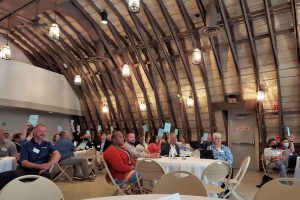
Members voting during the Board election
Next was our annual business meeting, a dedicated time where we hold our Board of Directors election and have our members share their accomplishments. Chelsea Harnish started this portion of the meeting with organizational updates, including the process of developing our 2023-2025 strategic plan. Afterward, Board Vice-Chair Mark Jackson (CHP Energy Solutions) led our 2022 Board of Directors election. VAEEC members re-elected seven Board members:
- Elizabeth Beardsley, U.S. Green Building Council
- Tim Bernadowski, Siemens Industry
- KC Bleile, Viridiant
- Bill Eger, City of Alexandria
- Stephen Evanko, Dominion Due Diligence Group
- Mark Jackson, CHP Energy Solutions, and
- Carrie Webster, Henrico County
Members elected Megan Partridge with Franklin Energy to fill an open seat on the Board of Directors. We also officially welcomed Joyce Bodoh (Rappahannock Electric Cooperative) and Bryna Dunn (Moseley Architects) to the Board. These individuals are fulfilling the terms of former Board members. We are excited to add new voices to our leadership and to continue working with our seven re-elected members.
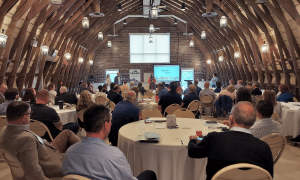
Remarkable Member Updates
After the remarkable member updates, a time for members to highlight their latest successes, and a networking break, attendees reconvened for our plenary session, Advancing Energy Efficiency in the Built Environment. Speakers included: Bryna Dunn (Moseley Architects), Andrew Grigsby (Viridiant), Abby Johnson (Virginia PACE Authority), and Benjamin Knopp (Community Housing Partners). Julia Reynolds (Chesterfield County) moderated.
While the keynote address focused on past successes and an overview of this year’s General Assembly session, this session was more forward-focused. Speakers touched on the latest and greatest opportunities for the field right now and their predictions for the next five years. They also covered the challenges and barriers, as well as the opportunities, they are seeing in their particular niche of the energy efficiency industry.
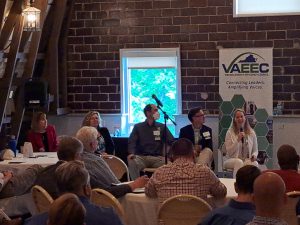
Advancing EE in the Built Environment
Abby focused on the statewide Commercial Property Assessed Clean Energy (C-PACE) program, including recent legislation that enhances the scope of C-PACE projects. Andrew emphasized the value of efficiency and green design and using funding to support social good. He also discussed the energy code work that Viridiant is doing with the Southeast Energy Efficiency Alliance. Ben talked about pushing the boundaries of weatherization with MERV-13 filtration, heat pump deployment, electrification, and weatherization deferral repairs. Bryna provided an overview of Moseley’s True Sustainability Program and how it ties together wellness, decarbonization, and resilience.
After closing remarks, the event concluded with a happy hour at Triple Crossing – Fulton in Richmond. With networking being one of the main benefits of a VAEEC membership, we were delighted to safely offer this in-person opportunity. It was a pleasure to connect with many of our members face-to-face again after primarily hosting virtual events for the past two years.
Thank you to our sponsors, speakers, and event attendees for making this one of our best events to date!
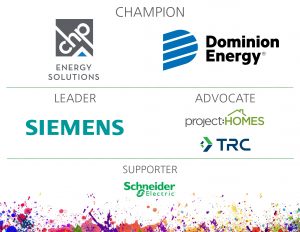
Additional event information, including speaker biographies and sponsor features, can be found in the event program. Event attendees received a PDF of the event’s presentation in the post-event email. Contact info@vaeec.org if you did not receive it. Events photos can be viewed in the photo gallery below.
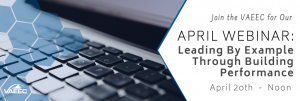 The VAEEC recently hosted a webinar on building performance primarily for local governments across the Commonwealth. Leading By Example Through Building Performance followed three different building performance policies and programs to not only encourage the audience to implement their own strong green building policy but to also provide best practices and lessons learned from the design phase all through the day-to-day management of a program.
The VAEEC recently hosted a webinar on building performance primarily for local governments across the Commonwealth. Leading By Example Through Building Performance followed three different building performance policies and programs to not only encourage the audience to implement their own strong green building policy but to also provide best practices and lessons learned from the design phase all through the day-to-day management of a program.
Speakers included:
- Dawn Oleksy, Climate Action Programs & Operations Supervisor, City of Richmond
- Bill Eger, Energy Manager, City of Alexandria
- Holly Savoia, Director of Sustainability Enforcement, NYC Department of Buildings, and
- Elizabeth Beardsley, Senior Policy Counsel, U.S. Green Building Council.
With Virginia being a Dillon Rule state, localities are limited as to what they can and cannot mandate. However, jurisdictions are finding ways to make progress happen in their communities.
The webinar began with an overview of green buildings and the benefits of a strong green building policy – such as energy savings, emission reductions, and improved air quality – from Liz. Next, Dawn covered the City of Richmond’s climate action policy, RVAgreen 2050, which the City is currently in the middle of developing. RVAgreen 2050 centers around three key points: equity, climate action, and climate resilience. Buildings & Energy is one of five pathways the City is using to meet its goal of achieving net-zero emissions by 2050 and becoming more climate-resilient. This includes requiring an equitable building performance policy for existing commercial buildings, retro-commissioning for existing commercial buildings to improve efficiency, and benchmarking existing commercial buildings.
RVAgreen 2050 is equitable climate action for a healthy and resilient Richmond.
Dawn specified the need for stakeholder engagement throughout the entire process in order to better understand the community’s priorities. She also shared RVAgreen 2050’s measuring process to track the plan’s outcomes and the shared accountability framework to encourage transparency, a culture of improvement, trusting relationships, institutionalizing sustainability in city government, and regular evaluation.
Richmond just began the next phase of community-wide engagement to gather feedback on the plan. RVAgreen 2050 is scheduled to be finalized this summer and adopted by fall.
Next, Bill provided an overview of the City of Alexandria’s Green Building Policy. The City initially enacted this policy in 2009. Alexandria created the Environmental Action Plan 2040 to support the City’s goals, which include climate action and energy reduction.
The Green Building Policy establishes minimum green building practices for new public and private development and major renovations.
To work around Virginia’s “constrained policy environment”, authority for this policy is rooted in the City’s zoning code. Certain building performance conditions are required for the Development Site Plan and Development Special Use Permit review processes. New development must achieve the LEED Silver level of certification at a minimum. Using a third-party rating system provides an expert verification of meeting compliance requirements without having to have experts on staff. The policy also includes a minimum threshold requirement for a number of community priorities, such as energy efficiency, renewable energy, and advanced energy metering.
The Green Building Policy was updated in 2019 to include newer concepts such as decarbonization. In the ten-year span between 2009 and 2019, over 95% of the development square footage constructed or currently under construction in Alexandria is compliant with the 2009 policy. This equates to nearly 10 million square feet of green building development.
Holly provided an overview of New York City’s Energy Grades Program, including the local sustainability laws that led to this program. PlaNYC set out to reduce the City’s emissions by 30% by 2030. The Greener, Greater Buildings Plan paved the way for benchmarking, energy audits and retro-commissioning, and lighting upgrades and sub-metering. Then, after Hurricane Sandy hit, the One City Built to Last Policy increased the emissions reduction goal to 40% by 2030 and 80% by 2050.
Commercial benchmarking served as the precursor to the City’s Energy Grades Program.
Since it provides transparency of a property’s annual energy and water usage, benchmarking is seen as the first step for building owners or tenants to make a building more efficient – you can’t change what you can’t measure.
The City’s commercial benchmarking mandate originally applied to buildings over 50,000 SF, but was later amended to apply to any building over 25,000 SF. Building owners must report their building’s energy and water consumption annually through the U.S. EPA’s Energy Star Portfolio Manager. Portfolio Manager is a readily accessible, free tool, so the municipality did not have to purchase it or develop their own benchmarking software. Additionally, building owners do not have to pay to use it or hire someone else to input the data, which helps lead to higher compliance rates. New York City has also created a way for building owners to automatically upload their data from their utility bills. Initially, violation fees were issued once a year. Now that they are issued on a quarterly basis, the City has a 96% compliance rate.
New York City’s Building Energy Grades Program applies to most buildings over 25,000 SF. The Department of Buildings uses a building’s benchmarking data to assign qualified buildings a letter grade distribution based on their Energy Star score. Owners are required to post their building’s Energy Efficiency Rating Label in a conspicuous location of their building’s entrance. The program provides transparency of a property’s energy efficiency to the public.
One of the key takeaways from all the speakers is the importance of getting the private sector involved early in the policy-making process. Getting them involved from the beginning not only increases buy-in but also allows localities to understand challenges that they may not have foreseen and to brainstorm solutions.
It was inspiring to see all of the thought and effort that goes into developing, implementing, and managing green building policies.
A recording of the webinar can be viewed here. Contact info@vaeec.org for more information.
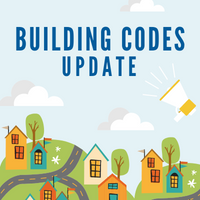 The building code update process in Virginia is underway this year. Workgroups have begun to meet to discuss proposals that have been submitted to DHCD for review. Below are several energy proposals that are currently under consideration by the DHCD energy subgroup committee, on which VAEEC executive director, Chelsea Harnish participates.
The building code update process in Virginia is underway this year. Workgroups have begun to meet to discuss proposals that have been submitted to DHCD for review. Below are several energy proposals that are currently under consideration by the DHCD energy subgroup committee, on which VAEEC executive director, Chelsea Harnish participates.
Note: You will need to register for a free account on the DHCD website to access the links below.
Proposals under consideration that the VAEEC supports:
EC-C407.6-21: Zero energy construction proposal to align all energy conservation codes with the 2021 IECC
REC-R402.1.2(1)-21: strikes VA amendments to fully adopt the 2021 IECC wall insulation requirements; this proposal was submitted by VAEEC member, Eric Lacey, of the Responsible Energy Codes Alliance (RECA). Using the DOE methodology for reviewing code change proposals, RECA determined that this proposal alone would improve efficiency a whopping 13%!
REC-R402.1.2(2)-21: strikes VA amendments to fully adopt the 2021 IECC wall insulation requirements; identical to the proposal above but submitted by a different patron.
REC-R402.4-21: strikes VA amendments to fully adopt the 2021 IECC air leakage requirements
REC-R402.4.1.2-21: requires 3ACH for air leakage but also provides a trade off for builders
REC-R403.3.3-21: updates air duct testing compliance to align with 2021 IECC
Additionally, the subgroup is also considering a proposal on electric vehicles:
REC-R404.2-21: Electric vehicles proposal to align residential energy code with the 2021 IECC
The Energy subgroup has taken positions on the following proposals, which were reviewed by the full working group on April 14th.
EC-C402.4-21: (Consensus) technical amendment to strikes Virginia amendment language currently in the Virginia Construction Code of the USBC that are either outdated or align with the 2021 IECC
EC1301.1.1.1-21: (Non-consensus) strikes Virginia amendments to fully adopt the 2021 IECC
America has a building problem.
Americans spend up to 90% of their lives indoors, in buildings that were not designed with ventilation in mind. The quality of indoor air affects all aspects of life – health, school and job performance, cognitive abilities, and energy bills.
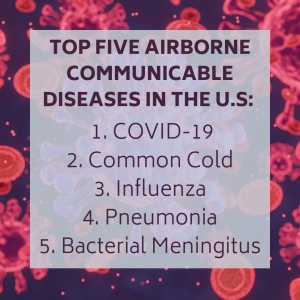 While COVID-19 brought indoor air quality into sharp focus, many of the most common – and often dangerous – communicable illnesses are spread through airborne transmission. Additionally, chronic illnesses like asthma, cardiovascular disease, and COPD are exacerbated by factors in the living environment. Comparative risk studies performed by EPA’s Science Advisory Board (SAB) have consistently ranked indoor air pollution among the top five environmental risks to public health. In fact, there is over thirty years of research on the effects of indoor air quality on human health and behavior.
While COVID-19 brought indoor air quality into sharp focus, many of the most common – and often dangerous – communicable illnesses are spread through airborne transmission. Additionally, chronic illnesses like asthma, cardiovascular disease, and COPD are exacerbated by factors in the living environment. Comparative risk studies performed by EPA’s Science Advisory Board (SAB) have consistently ranked indoor air pollution among the top five environmental risks to public health. In fact, there is over thirty years of research on the effects of indoor air quality on human health and behavior.
Improvements to air filtration and ventilation have lagged behind other building systems for years, leading to what Dr. Vin Gupta, the Chief Health Officer at Amazon, calls “the biggest challenge for public and workspaces of this century.”
“Go back 100 years. The big issue that was killing people were communicable diseases passed fecal to oral,” Gupta said. This issue led to improvements in sanitation and waste disposal across the world. “100 years later, it is how do we ventilate public space and workplaces.”
Building owners and residents need to prioritize improved indoor air quality in their spaces. “Treat indoor air quality like a must-have work benefit, not a trendy perk” said Prof. Joseph Allen, associate professor at the Harvard T.H. Chan School of Public Health. Allen is also leading ongoing research on the correlation between indoor air quality and health.
Allen was a leading author on a recent study that explored the coexistence of energy efficiency and health. The third in a series that focused on the effects of air quality on cognitive function, researchers concluded that cognitive scores averaged between 61-101% higher in green building designs over conventional buildings. The authors stated these findings have “wide-ranging implications” as the study mimicked many typical indoor environments.
Typically, increases in ventilation and filtration result in an increase in energy use, but by leveraging equipment controls and efficient equipment, these programs help building owners and residents keep energy increases manageable.
George Barnes, Account Manager for Complex Solutions for Trane said, “the challenge is to complete [measures] in an energy efficient manner. If done correctly, spaces will be safer, occupants will be healthier, and any cost increases will be mitigated.”
Energy efficiency and green building also reduces absenteeism in schools and the workplace, improves workforce retention and productivity, and contributes to better comfort for residents and workers. As employers bring workers back into physical offices, it is critical that everyone – building owners, CEOs, employees, and more – keep a keen eye on the health of the buildings and the people within them.
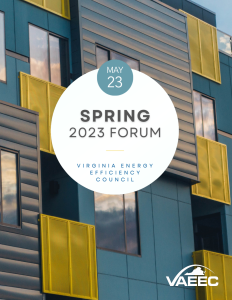
 Approximately 1/3 of our greenhouse gas emissions are from the new and existing building stock. The HUB emphasizes the importance of transitioning from looking at buildings as the problem to looking at them as the opportunity. And above all, we cannot forget that buildings are for people, which is especially true when you consider that we spend roughly 90% of our lives in buildings. Therefore, they must support the community around them by focusing on energy efficiency, resiliency, and health and safety.
Approximately 1/3 of our greenhouse gas emissions are from the new and existing building stock. The HUB emphasizes the importance of transitioning from looking at buildings as the problem to looking at them as the opportunity. And above all, we cannot forget that buildings are for people, which is especially true when you consider that we spend roughly 90% of our lives in buildings. Therefore, they must support the community around them by focusing on energy efficiency, resiliency, and health and safety. Attendees were next treated to a round robin of updates and successes from our members before moving into a networking break. After reconvening, the plenary session began. Meeting the Moment for Building Demand touched on the how the federal climate initiatives passed by the Biden administration will change the energy landscape for decades to come, before moving into how experts from across the field are planning to implement successful programs and projects using the funds. The discussion also included how we can make this round of funding more “durable” than that of the American Recovery & Reinvestment Act (ARRA) era to create systemic change and avoid the “one and done” projects.
Attendees were next treated to a round robin of updates and successes from our members before moving into a networking break. After reconvening, the plenary session began. Meeting the Moment for Building Demand touched on the how the federal climate initiatives passed by the Biden administration will change the energy landscape for decades to come, before moving into how experts from across the field are planning to implement successful programs and projects using the funds. The discussion also included how we can make this round of funding more “durable” than that of the American Recovery & Reinvestment Act (ARRA) era to create systemic change and avoid the “one and done” projects. Be sure to save the date for our fall Energy Efficiency Forum– October 4th (virtual), October 5th (in-person, University of Richmond). We hope to see you there.
Be sure to save the date for our fall Energy Efficiency Forum– October 4th (virtual), October 5th (in-person, University of Richmond). We hope to see you there.
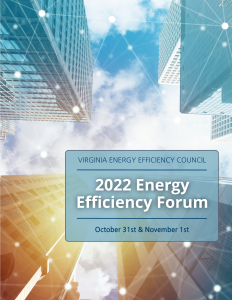

 Virginia’s
Virginia’s  In September of this year, we held two building performance roundtable discussions with localities, state agencies, schools, architecture and design firms, engineering firms, and energy service companies. The goals were to educate stakeholders about the requirements and identify ways to update the law so that it better suits the needs of the intended audience.
In September of this year, we held two building performance roundtable discussions with localities, state agencies, schools, architecture and design firms, engineering firms, and energy service companies. The goals were to educate stakeholders about the requirements and identify ways to update the law so that it better suits the needs of the intended audience. 

 The Virginia Energy Efficiency Council (VAEEC) recently hosted a webinar,
The Virginia Energy Efficiency Council (VAEEC) recently hosted a webinar,  During this year’s General Assembly Session, the VAEEC worked with Virginia Energy and our ESCO members to update the Commonwealth’s existing EPC legislation. Once these laws take effect, EPC will be able to finance all roof repairs and full replacements, allowing public buildings to use EPC to become solar-ready. This will provide public bodies with the opportunity to fully finance solar under an EPC (see our
During this year’s General Assembly Session, the VAEEC worked with Virginia Energy and our ESCO members to update the Commonwealth’s existing EPC legislation. Once these laws take effect, EPC will be able to finance all roof repairs and full replacements, allowing public buildings to use EPC to become solar-ready. This will provide public bodies with the opportunity to fully finance solar under an EPC (see our  EPC provides the school system with the fiscal advantage of financing energy efficiency retrofits from realized future energy savings. Additional benefits include expertise in design, planning, implementation, and communication; resources that guarantee long-term success; the inclusion of non-energy conservation measures projects (such as security systems); and a trusted partnership between LCPS and their selected ESCO, CMTA. Not only did CMTA understand the nuances of working in an educational environment, but they offered staff training for LCPS employees and have participated in educational opportunities for students.
EPC provides the school system with the fiscal advantage of financing energy efficiency retrofits from realized future energy savings. Additional benefits include expertise in design, planning, implementation, and communication; resources that guarantee long-term success; the inclusion of non-energy conservation measures projects (such as security systems); and a trusted partnership between LCPS and their selected ESCO, CMTA. Not only did CMTA understand the nuances of working in an educational environment, but they offered staff training for LCPS employees and have participated in educational opportunities for students.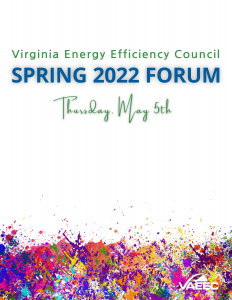





 The VAEEC recently hosted a webinar on building performance primarily for local governments across the Commonwealth. Leading By Example Through Building Performance followed three different building performance policies and programs to not only encourage the audience to implement their own strong green building policy but to also provide best practices and lessons learned from the design phase all through the day-to-day management of a program.
The VAEEC recently hosted a webinar on building performance primarily for local governments across the Commonwealth. Leading By Example Through Building Performance followed three different building performance policies and programs to not only encourage the audience to implement their own strong green building policy but to also provide best practices and lessons learned from the design phase all through the day-to-day management of a program. The building code update process in Virginia is underway this year. Workgroups have begun to meet to discuss proposals that have been submitted to DHCD for review. Below are several energy proposals that are currently under consideration by the DHCD energy subgroup committee, on which VAEEC executive director, Chelsea Harnish participates.
The building code update process in Virginia is underway this year. Workgroups have begun to meet to discuss proposals that have been submitted to DHCD for review. Below are several energy proposals that are currently under consideration by the DHCD energy subgroup committee, on which VAEEC executive director, Chelsea Harnish participates.